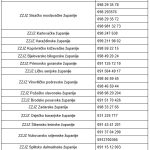As Poslovni Dnevnik writes on the 11th of May, 2020, the ELISA test is a method of serological diagnosis that detects certain classes of antibodies, IgM, IgG and IgA in the patient’s serum. The first serological testing to see just how many of Croatia’s residents have actually been infected with the new coronavirus, perhaps without ever knowing, has now begun.
The Croatian Institute of Public Health (HZJZ) has started coronavirus serological testing which should provide us with a long-awaited answer about the prevalence of coronavirus in the population of Croatia, ie, what percentage of Croatia’s residents have been infected, perhaps asymptomatically. Serological testing includes 1,100 blood samples from citizens collected from hospital laboratories, health centres and public health institutes.
”So far, as part of the validation of these tests, in addition to serum samples from patients who have been confirmed to have had a coronavirus infection, we’ve also tested 120 people from the general population and healthcare professionals with the ELISA test. Based on such a small number of respondents, it’s currently much too early to talk about the prevalence of coronavirus among the general population. As announced by the director of the CNIPH, Dr. Krunoslav Capak, this week, we’ll begin testing a larger number of respondents, which will allow for us to gain a better insight into the level of infection of our population,” said Dr. Tatjana Vilibic-Cavlek, head of the Department of Virological Serology of the CIPH, for Jutarnji list.
”The ELISA test is a method of serological diagnosis which proves the presence of certain classes of antibodies, IgM, IgG and IgA, in the patient’s serum. Depending on the proven antibodies, we can tell if it they’ve had an acute or recent infection, or if they’ve had earlier contact with the virus. If a person has antibodies to SARS-CoV-2, it means that they have acquired immunity, but we don’t know much more about the duration of that immunity because this coronavirus is a brand new virus and too little time has passed since its appearance to talk about long-term immunity,” she added.
Serological tests are also being conducted in other European Union countries, and results from the Czech Republic and neighbouring Slovenia show that between two and five percent of the population have been infected with the new coronavirus in those countries.
In the event that something of a similar result here in Croatia, it would, according to estimates, mean that a maximum of 125,000 Croatian residents have been infected, which is certainly insufficient to achieve collective immunity (herd immunity), which is between 60 and 70 percent in the case of the new coronavirus. That is, for the SARS-CoV-2 coronavirus to stop spreading among a population, its infection rate must be between 60 and 70 percent.
Make sure to follow our dedicated section for more on coronavirus in relation to Croatia.










